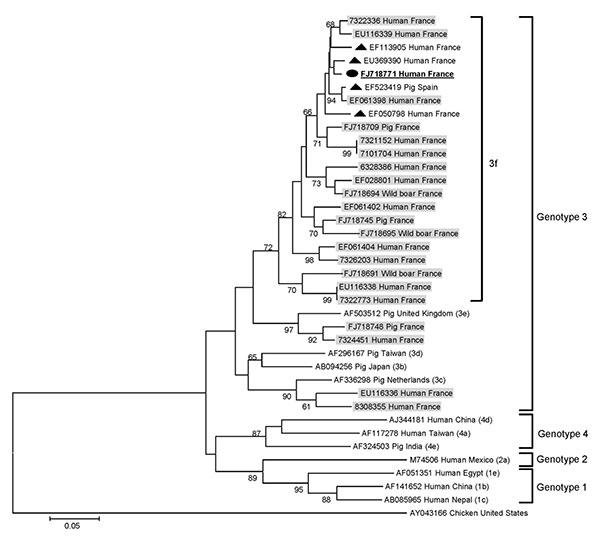Volume 16, Number 11—November 2010
Dispatch
Hepatitis E Virus Infection in Sheltered Homeless Persons, France
Figure

Figure. Phylogenetic tree based on partial nucleotide sequences (275 bp) corresponding to the 5′-end open reading frame 2 region of the hepatitis E virus (HEV) genome. Phylogenetic analysis included HEV sequence recovered in the present study (black circle, boldface and underlined; GenBank accession no. FJ71877) and sequences corresponding to the HEV sequences hits with the highest BLASTn score (http://blast.ncbi.nlm.nih.gov) to this sequence (black triangles), previously recovered in our laboratory (boldface), and of previously determined genotypes and subtypes (2) (in parentheses). Shading indicates sequences previously isolated in our laboratory. Bootstrap values >60% of 1,000 resamplings of the data are indicated. Avian HEV sequence AY043166 was used as an outgroup. The names of HEV sequences are labeled as follows: GenBank accession no., host, and country of origin where recovered. Scale bar indicates number of nucleotide substitutions per site.
References
- Dalton HR, Bendall R, Ijaz S, Banks M. Hepatitis E: an emerging infection in developed countries. Lancet Infect Dis. 2008;8:698–709. DOIPubMedGoogle Scholar
- Lu L, Li C, Hagedorn CH. Phylogenetic analysis of global hepatitis E virus sequences: genetic diversity, subtypes and zoonosis. Rev Med Virol. 2006;16:5–36. DOIPubMedGoogle Scholar
- Teo CG. Hepatitis E indigenous to economically developed countries: to what extent a zoonosis? Curr Opin Infect Dis. 2006;19:460–6. DOIPubMedGoogle Scholar
- Badiaga S, Raoult D, Brouqui P. Preventing and controlling emerging and reemerging transmissible diseases in the homeless. Emerg Infect Dis. 2008;14:1353–9. DOIPubMedGoogle Scholar
- Leon P, Venegas E, Bengoechea L, Rojas E, Lopez JA, Elola C, Prevalence of infections by hepatitis B, C, D and E viruses in Bolivia. Rev Panam Salud Publica. 1999;5:144–51. DOIPubMedGoogle Scholar
- Smith HM, Reporter R, Rood MP, Linscott AJ, Mascola LM, Hogrefe W, Prevalence study of antibody to ratborne pathogens and other agents among patients using a free clinic in downtown Los Angeles. J Infect Dis. 2002;186:1673–6. DOIPubMedGoogle Scholar
- Kaba M, Davoust B, Marie JL, Barthet M, Henry M, Tamalet C, Frequent transmission of hepatitis E virus among piglets in farms in Southern France. J Med Virol. 2009;81:1750–9. DOIPubMedGoogle Scholar
- Boutrouille A, Bakkali-Kassimi L, Cruciere C, Pavio N. Prevalence of anti-hepatitis E virus antibodies in French blood donors. J Clin Microbiol. 2007;45:2009–10. DOIPubMedGoogle Scholar
- Mansuy JM, Legrand-Abravanel F, Calot JP, Peron JM, Alric L, Agudo S, High prevalence of anti-hepatitis E virus antibodies in blood donors from South West France. J Med Virol. 2008;80:289–93. DOIPubMedGoogle Scholar
- Bendall R, Ellis V, Ijaz S, Ali R, Dalton H. A comparison of two commercially available anti-HEV IgG kits and a re-evaluation of anti-HEV IgG seroprevalence data in developed countries. J Med Virol. 2010;82:799–805. DOIPubMedGoogle Scholar
- Legrand-Abravanel F, Thevenet I, Mansuy JM, Saune K, Vischi F, Peron JM, Good performance of immunoglobulin M assays in diagnosing genotype 3 hepatitis E virus infections. Clin Vaccine Immunol. 2009;16:772–4. DOIPubMedGoogle Scholar
- Gessoni G, Manoni F. Hepatitis E virus infection in north-east Italy: serological study in the open population and groups at risk. J Viral Hepat. 1996;3:197–202. DOIPubMedGoogle Scholar
- Sylvan SP. The high rate of antibodies to hepatitis E virus in young, intravenous drug-abusers with acute hepatitis B virus infection in a Swedish community: a study of hepatitis markers in individuals with intravenously or sexually acquired hepatitis B-virus infection. Scand J Infect Dis. 1998;30:429–30.PubMedGoogle Scholar
- Christensen PB, Engle RE, Jacobsen SE, Krarup HB, Georgsen J, Purcell RH. High prevalence of hepatitis E antibodies among Danish prisoners and drug users. J Med Virol. 2002;66:49–55. DOIPubMedGoogle Scholar
- Thomas DL, Yarbough PO, Vlahov D, Tsarev SA, Nelson KE, Saah AJ, Seroreactivity to hepatitis E virus in areas where the disease is not endemic. J Clin Microbiol. 1997;35:1244–7.PubMedGoogle Scholar